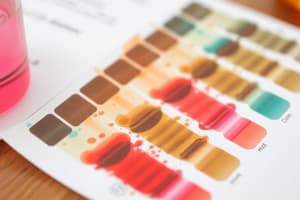Podcast
Questions and Answers
What is the purpose of chromatography?
What is the purpose of chromatography?
- To measure the concentration of a substance in a solution.
- To determine the chemical structure of a compound.
- To identify and separate the components of a mixture based on their relative distribution between the mobile and stationary phases. (correct)
- To analyze the physical properties of a substance.
Which of the following is NOT a step in the chromatography process?
Which of the following is NOT a step in the chromatography process?
- Selecting a suitable development method.
- Spotting the sample on the paper using a capillary tube.
- Preparing the sample by dissolving it in a suitable solvent.
- Analyzing the sample under a microscope. (correct)
What is the role of the mobile phase in chromatography?
What is the role of the mobile phase in chromatography?
- To react with the sample and change its chemical properties.
- To dissolve the sample and transport it through the stationary phase. (correct)
- To provide a stationary environment for the separation of components.
- To measure the amount of each component in the mixture.
Why is High-Performance Liquid Chromatography (HPLC) popular in many labs?
Why is High-Performance Liquid Chromatography (HPLC) popular in many labs?
What is the purpose of selecting a suitable filter paper in chromatography?
What is the purpose of selecting a suitable filter paper in chromatography?
Which of the following is NOT a typical application of chromatography?
Which of the following is NOT a typical application of chromatography?
How does the capillary action of the paper contribute to the separation of components in chromatography?
How does the capillary action of the paper contribute to the separation of components in chromatography?
In which of the following areas is chromatography NOT commonly used?
In which of the following areas is chromatography NOT commonly used?
Flashcards
Chromatography
Chromatography
A technique used to separate the components of a mixture based on their different affinities for a stationary phase and a mobile phase.
Solute
Solute
The substance being separated in chromatography (e.g., the different colors in ink).
Mobile Phase
Mobile Phase
The moving fluid (liquid or gas) in chromatography that carries the solutes.
Stationary Phase
Stationary Phase
Signup and view all the flashcards
Chromatogram Development
Chromatogram Development
Signup and view all the flashcards
High-Performance Liquid Chromatography (HPLC)
High-Performance Liquid Chromatography (HPLC)
Signup and view all the flashcards
Gas Chromatography (GC)
Gas Chromatography (GC)
Signup and view all the flashcards
Chromatogram
Chromatogram
Signup and view all the flashcards
Study Notes
Chromatography Techniques
- Chromatography is a technique used to separate components of a mixture based on their relative distribution between a mobile phase (moving fluid stream) and a stationary phase (contiguous phase).
- Mobile phase can be liquid or gas.
- Stationary phase can be solid or liquid.
Steps in Paper Chromatography
- Select suitable type of development based on the complexity of the mixture, solvent, and paper.
- Select suitable filter paper based on the size of pores and sample quality.
- Prepare the sample by dissolving it in a suitable solvent (inert to the sample).
- Spot the sample on the paper using a capillary tube at a proper position.
- Develop the chromatogram by immersing the paper in the mobile phase.
- Dry the chromatogram using an air dryer to detect compounds.
- Spray the chromatogram with a solution to identify components.
Uses of Chromatography
- Quality control for testing contaminants in food, beverages, and other materials.
- Purify organic compounds in solid, liquid, or gas form.
- Sample preparation: separate components from a sample.
- Chemical analysis: analyze chemical composition of food and other materials.
- Forensic science: identify and compare samples of drugs, explosives, inks, and biological samples.
Chromatography Techniques
- Gas Chromatography: Arguably the most popular method, high-performance liquid chromatography is a close second. Favorable due to efficiency using a liquid (or solvent) mobile phase. This method uses a high-pressure pump to push the sample through the equipment
- Diagram of gas chromatography equipment provided. (Injection port, column, oven, detector, computer/data analysis, carrier gas, and gas flow pressure regulator)
- Paper Chromatography: A technique for separating dissolved chemical substances based on their different migration rates across sheets of paper.
- Diagram of paper chromatography experiment setup provided.
- Thin-Layer Chromatography (TLC): Separates components in non-volatile mixtures using a TLC plate coated with a thin layer of adsorbent material. Diagram of an TLC experiment setup provided
- Column Chromatography: A preparative technique to purify compounds based on their polarity or hydrophobicity, separates molecules based on their different partitioning between a mobile and stationary phase.
- High-Performance Liquid Chromatography (HPLC): Separates compounds dissolved in a liquid sample. Allows qualitative and quantitative analysis to determine which components are present and their quantity.
- Diagram of HPLC setup provided(Liquid Sample, Column(Stationary Phase), Solvent Delivery Pump, Mobile Phase,Detector)
Studying That Suits You
Use AI to generate personalized quizzes and flashcards to suit your learning preferences.
Related Documents
Description
Explore the principles and techniques of chromatography, including paper chromatography. Learn about the steps involved in the process, from selecting materials to identifying components. This quiz covers various aspects and applications of chromatography in quality control and analysis.



